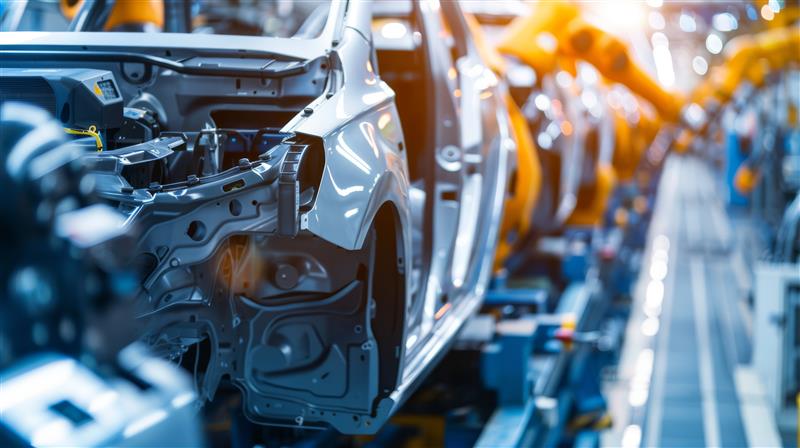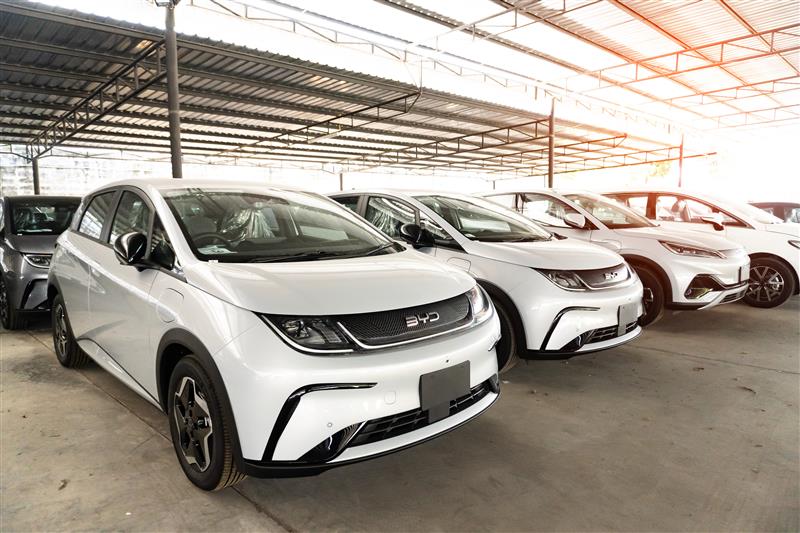IQ
Insight
Quarterly
Q1 | 2025
FT Live's Future of the Car Summit 2025: Five trends transforming the automotive industry
5 min read
With three days of keynote interviews and panels, FT Live’s Future of the Car Summit 2025 saw manufacturers, technology pioneers and policy makers discuss how the industry is navigating an ever-evolving car market. From electrification progress and roadblocks, to supply chain strategies and the changing geo-political landscape, this year’s event highlighted five trends transforming the automotive industry in 2025 and beyond.
As a lead sponsor with two panel speakers including Martin Forbes, President of Cox Automotive International, and Strategy and Growth Director, Karoline Baumann, we were there to take part in the conversation and soak up insights from industry players.
Here’s the key automotive industry trends that were discussed:

1. Tackling tariffs: Localised supply chains lead automotive manufacturing trends
When talking about automotive manufacturing trends, it was unsurprising to hear US tariffs come up time and time again over the three days. With many questioning how the industry can tackle these fees and other increased costs across the supply chain, while keeping vehicles affordable for the consumer.
For manufacturers like Volvo, the answer lies in localised supply chains. While the Covid-19 pandemic saw the need for diversified supply chains, the increasing costs of importing materials and vehicles is making it a challenging strategy for the future. Instead, building vehicles and sourcing components closer to global markets helps manufacturers futureproof their business by reducing costs and protecting margins by avoiding tariffs and unlocking access to regional incentives.
As pointed out by various keynote speakers, localisation isn’t just about cost reduction. This approach also strengthens relationships with global governments and consumers, who will have a better experience due to quicker lead times and better prices. Similarly, shorter supply chains mean faster response times and more agile manufacturing, therefore creating a greater resilience to market disruption – something that speakers raised as a key challenge for them in recent years.
2. Chinese automotive technology is shaping global innovation
With the Shanghai Motor Show taking place just weeks before the Future of the Car Summit, many manufacturers and industry experts expressed excitement in the technologies and engineering they witnessed from Chinese brands. Two key findings stood out:
i. Modular manufacturing has led to great success
The Chinese OEM modular manufacturing system was described as impressive and inspirational for European and UK-based OEMs, thanks to the highly standardised and flexible automotive technology. Working on a modular system allows for designing and assembling vehicles using interchangeable modules or components across multiple models or vehicle types. In a nutshell, everything from compact city cars to SUVs could be built using a singular modular architecture.

The result is paramount, with Chinese OEMs achieving seamless and quick production at scale, while reducing costs and responding quickly to evolving consumer preferences and market regulations.
ii. UK and Europe must learn from EV battery production in China
With the future of mobility being electric, Chinese manufacturing couldn’t be discussed without mentioning their dominance in EV battery production, underpinned by many strategic advantages:
- Lower costs: With lower labour costs, economies of scale and regionalised supply chains covering everything from raw materials to cell manufacturing and assembly, Chinese OEMs are producing EV batteries significantly cheaper than Europe and North America.
- Access to raw materials: Controlling a substantial share of the global supply of raw materials like lithium, cobalt and graphite puts China at a huge advantage when it comes to battery production. While other countries also mine large amounts of some of these necessary materials, China dominates when it comes to refining and processing them into usable battery-grade chemicals, solidifying their supply chain dominance.
- Vertical integration: Thanks to this local access, manufacturers like BYD have implemented high levels of vertical integration with great success. Producing most of their components in house and reducing reliance on external suppliers subsequently reduces production costs.
- Government investment: The Chinese government has invested heavily into the EV market, providing subsidies, tax incentives and infrastructure development to allow for more rapid growth.
Not only do these advantages mean they’re able to produce EV batteries at scale for a lower cost, but it also gives them the ability to develop and integrate advanced battery technologies including enhancing performance and safety features, making them more appealing to the global market.
The key message from European and UK manufacturers, however, wasn’t one of concern. Instead, many expressed excitement and urgency to collaborate with Chinese OEMs while navigating current automotive technology shifts, learning valuable lessons from their speed, scalability and affordability.
3. Automotive electrification needs fixed regulation and better strategy
Any conversation about automotive manufacturing trends in 2025, wouldn’t be complete without discussing automotive electrification and the policies shaping its progress. While sustainability innovation and supply chain challenges were discussed at length, a standout theme was the need for regulation clarity, something our Strategy and Growth Director, Karoline Baumann mentioned during her panel discussion.
With automotive manufacturers generally working five to seven years in advance, the ever-changing regulations causes a lack of confidence in potential investors and OEMs alike. In response, speakers called for reassurance that policy makers refrain from constant rule changes, allowing manufacturers and other industry players to create an automotive electrification strategy they can rely on.
Representatives from Renault mentioned the resource that goes into engineers monitoring and adapting to these new regulations, ultimately taking away from production and innovation priorities. While others insisted the industry needs clarity to build robust strategies that can effectively meet the 2030 and 2035 targets, which remain the same despite alterations to targets leading up to the final deadline. As it stands, manufacturers are having to operate reactively which reduces efficiency and effectiveness, while taking away from sustainability efforts.
4. EV adoption challenges: The roadblocks slowing automotive electrification
Automotive electrification isn’t just facing challenges in production and supply chains, but in wider adoption too.

While new EV sales have seen growth in recent years, industry experts expressed concerns that the used electric vehicle market is struggling to keep up. This is due to nervous consumers and an oversupply of used EVs, largely thanks to end of contract corporate fleet vehicles coming to the second-hand market.
The inability to shift these used EVs comes down to residual values remaining low, and as a result, high monthly finance payments. Used EVs are therefore unattractive to dealers who worry they cannot sell them, and consumers who can’t afford them.
For Paul Hyne, Commercial Director at Lloyds Banking Group and others, the way to combat this lies in better consumer education. Earlier this year, we predicted a stall in the growing EV market for this very reason, and the data in our latest Insight Quarterly report confirms it. Our earlier research which surveyed over 2,000 UK drivers, highlighted that for automotive electrification to stick, there’s a need for better transparency on battery degradation – something standardised battery health reports could assist with – and better education at the discovery stage.
There’s no denying that the future of mobility is electric, but event discussions only further emphasised the need to focus not only on production and regulations, but how to encourage drivers to make the switch.
5. Data-led strategies are driving the future of mobility and automotive industry transformation
Even with regulation stability, profitable supply chains and the introduction of innovative automotive technologies, the landscape is undeniably complex and continues to evolve rapidly thanks to consumer preferences and economic factors.
The only way dealers, OEMs and fleet operators can keep up is via data-led strategies – a fact that pretty much all panellists and speakers discussed to some degree.

While not necessarily a shock in the digital world, as a business passionate about real-time insights driving our customers forward, it was great to hear all the ways data is being used to create efficiencies and support sustainability initiatives outside of types of vehicles sold.
Speakers discussed their success with data-first strategies from optimising fleet performance, monitoring EV battery health, remarketing stock to retailers and developing smart vehicle to grid technology. Highlighting just how much data gives the ability to make faster, smarter decisions that ultimately protect their bottom line.
This year’s Future of the Car Summit underscored one clear message: the industry is at a pivotal point. From the influence of Chinese automotive technology, regulatory uncertainty and strategic shifts to the challenges of automotive electrification, these five trends transforming the automotive industry are shaping a long-term strategy.
---
At Cox Automotive, we’re committed to helping our partners adapt to the evolving market using real-time insight to make confident decisions and preparing for the future of mobility. The road ahead is certainly complex, but with the right tools and collaboration, it’s full of exciting potential.
Futureproof your strategy and subscribe to future editions of Insight Quarterly to stay ahead of the curve.






